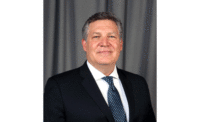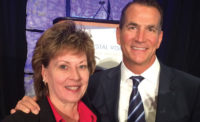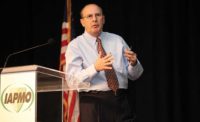Recently, pme interviewed Russ Chaney, CEO of The IAPMO Group, about his organization that develops the Uniform Plumbing, Mechanical, Swimming Pool and Solar Energy Codes, tests and certifies plumbing and mechanical products in the United States and overseas. Recent additions to The IAPMO Group include the Backflow Prevention Institute, Green Plumbers USA, the Radiant Professionals Alliance and ASSE-International.
Chaney came to the International Association of Plumbing and Mechanical Officials as CEO in 1995 when the organization faced significant financial and legal issues. In the years since, IAPMO’s annual budget has grown from $2.5 million to more than $40 million.
Before joining IAPMO, Chaney worked in code development for the Plumbing-Heating-Cooling Contractors – National Association. He had served as the state executive for the New Jersey PHCC and was a partner in a plumbing contracting firm in New Jersey for 13 years. He currently is serving as chairman of the World Plumbing Council.
pme: What has been your biggest accomplishment as IAPMO’s CEO?
RC: One of our biggest accomplishments was keeping IAPMO from going into bankruptcy shortly after I came here. Since then, one of the fundamental foundations of our success has been recruiting the best and brightest minds in our industry. There’s a long list of staff people who are much smarter than I am who came on board. They not only provided stability but also credibility, brainpower and experience.
Opening businesses outside the United States was something I thought would help us. We opened an office in China in 1998, and nobody had done that in our industry. In hindsight, it probably was one of the best moves we ever made. We have 600 to 700 clients in China right now.
pme: Where do you see the greatest opportunities for growth for IAPMO in the next five years?
RC: If I look five to eight years in advance, I think energy efficiency and water conservation will continue to be important issues. I’m referring to solar, geothermal and radiant systems, and hence our desire to have RPA be a part of The IAPMO Group. We’re amending our codes to incorporate those green technologies, which dovetail with our reasons for developing the Green Plumbing and Mechanical Code Supplement.
pme: How does the RPA fit with your goals for IAPMO?
RC: Just before we acquired http://www.radiantprofessionalsalliance.org/ RPA two years ago, IAPMO had been talking about expanding the Uniform Solar Energy Code to include hydronic, radiant and geothermal systems. We had decided five years ago to start to invest heavily in solar product and standard development, education, and all the underpinning services that go into publishing and developing codes and standards.
The professionals who belonged to RPA and were involved in radiant and geothermal projects dovetailed into that strategy perfectly. We were able to offer RPA the infrastructure of staff, administrative capabilities for the membership and the fact that we can expand the Solar Energy Code to incorporate geothermal, hydronic and radiant provisions. We saw it as a good fit. Two years later, it looks even better.
We’ve already embarked on developing the hydronic and radiant provisions of the 2015 code cycle. The Uniform Solar Energy Code is changing to the Uniform Solar Energy and Hydronics Code.
pme: How involved was IAPMO in the new federal law on no-lead plumbing products?
RC: IAPMO was involved in two ways, education and compliance. We were an active part of the Get the Lead Out Plumbing Consortium with PHCC, ASPE, PMI and MCAA. We agreed as a coalition to help disseminate that information as much as we could nationally and locally. The information targets the entire industry: code officials, installers, manufacturers and engineers.
IAPMO has done its part on the education side by creating a very professional-looking program that’s being used by people at the local and national levels. We took it online as a Web-based training tool. Since the end of November, 174 people have taken the Web course, including 17 from outside the United States.
On the client side, the biggest issue installers and designers have is making sure they’re in compliance. Part of the accountability chain is when the product comes into commerce, and those people are where products enter commerce. Product certification is going to be a huge piece of making sure that people are aware the products they’re specifying, purchasing and installing are legitimate. IAPMO will be involved in the testing and certification of the products along with ASSE.
Once the no-lead requirements get in the model code and get adopted at the state or local level, then they will have enforcement teeth. That’s another vehicle where IAPMO will be involved.
pme: What positive attributes of the Uniform Plumbing and Mechanical Codes distinguish them from other model codes?
RC: One positive attribute of our codes is that they embrace the entire industry — contractors, engineers, manufacturers and labor — and entitle them to have an equal vote during and after the process when everyone must stand up and be counted. That’s something that many of our members view as a benefit they can’t get somewhere else.
Another positive attribute is our unstinting focus on customer service. You get that when you have to be competitive and constantly strive to meet your client’s needs. IAPMO and the International Code Council have proven to each other that having competition is not necessarily a bad thing. It keeps all of us grounded on earth.
More than two-thirds of our revenue comes from product certification and testing. A very small amount of our income comes from the publication of codes and standards. The manufacturing community, unlike 20 years ago, is now the key area of business focus for The IAPMO Group. The same holds true for ASSE, whose future, in my view, will be tied to expanding its services to its manufacturer clients.
pme: Why did IAPMO decide to join forces with the ASSE-International?
RC: Members of http://www.asse-plumbing.org/ ASSE typically are members of IAPMO. More than any other two organizations in the plumbing industry, we have members in common. Some of that is because the United Association traditionally has been involved in both IAPMO and ASSE. Another major reason is the manufacturing sector. The services that ASSE offers to the industry and what IAPMO has expanded to offer are very similar also: product certification, standards development, personnel certification and backflow testing.
One issue ASSE faced was the increased competition from IAPMO, NSF, CSA and ICC on product certification where ASSE gets the majority of its funds. ASSE has been very proud of what it has accomplished in the past and what it can accomplish in the future. ASSE had goals that it felt it did not have the resources to accomplish on its own.
Some of our international work, such as our involvement in the World Plumbing Council, helped us come together with ASSE. We made ASSE an international chapter of The IAPMO Group. We wanted to retain the brand identity and recognition throughout the industry.
pme: What one or two items are at the top of your to-do list at IAPMO?
RC: I want IAPMO to be on sound financial footing. I want it to be a leader and a contributor to the industry and work well with any number of organizations around the world. We consider ourselves as making contributions to the international community as much if not more so than we do here in North America.





